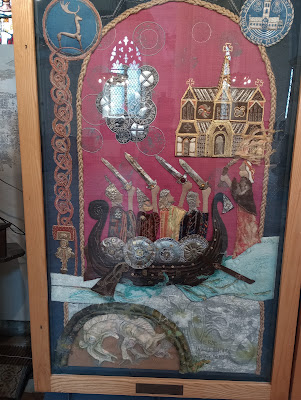Ancilla
writes:
In the year 1200, Ipswich was granted the Royal Charter by King John (of Robin
Hood fame). Eight hundred years later, in AD 2000, Isabel Clover designed eight
hangings to commemorate this important part of history for Ipswich Town.
The
hangings had many sponsors: Ipswich Borough Council, Ipswich Port Authority,
and Ipswich Decorative and Fine Arts Society, among others. The hangings had 40
City and Guild students and former students working on them over 3 years, and
they are now exhibited at St Peters-by-the-Waterfront (which has free admission).
Side-by-side it is easy to see the theme running through all eight panels, the River Orwell, which has been wonderfully created with silk velvet. Each panel represents a century, taking a snapshot of what was happening and what Ipswich Town looked like.
It really is very well done, with a variety of stitches and mediums used to create the story of time and place. The main technique used is Applique, which will be familiar to many and is the first course of the Diploma offered at the RSN. There is also quite a bit of Goldwork, scattered throughout the panels.
They are a great inspiration as to what can be achieved with
hangings or banners. It shows that Ecclesiastical Banners, Guild Banners,
Society Banners, etc., have their place in our communities still, whether large
or small. The Guild of St Clare has been instrumental in making and preserving
such banners; may God bless the work!






